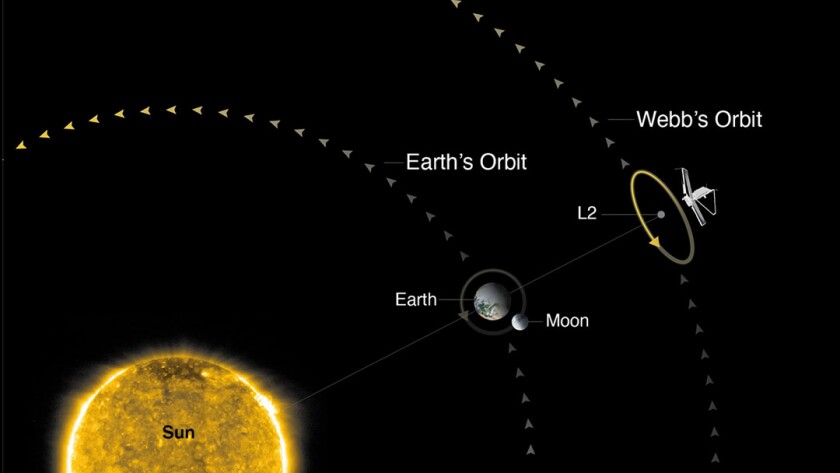DULUTH — We're one big step closer to cracking open deep time. On Tuesday, Jan. 4, the James Webb Space Telescope team successfully deployed the spacecraft’s 70-foot sunshield. About the size of a tennis court, the shield had to be folded origami-style so it would fit inside the Ariane 5 rocket that launched it toward its destination 1 million miles (1.5 million kilometers) from Earth. Deployment of the shield started three days after launch Dec. 28, 2021, and was completed at 10:59 a.m. Tuesday.
No country has ever attempted to put a telescope this big into space, let alone one requiring a bulky but fragile sun blocker. The unfolding and tensioning of Webb's sunshield involved 139 of its 178 release mechanisms, 70 hinge assemblies, eight deployment motors, roughly 400 pulleys and 90 individual cables totaling roughly one-quarter of a mile in length. And it all worked. Go ahead, and feel proud to be human. There's still hope for our species.
ADVERTISEMENT
Resembling a Viennese torte, the five-layered sunshield will protect the telescope from the light and heat of the sun, Earth and moon. Each plastic sheet is about as thin as a human hair and coated with reflective metal, providing protection for the telescope equivalent to a sunscreen lotion with an SPF of more than a million.

Webb's instruments and the telescope itself must be kept chilled to less than 380 degrees below zero Fahrenheit (229 degrees below zero Celsius) or about 80 degrees Fahrenheit above absolute zero, the coldest temperature possible. This protection is crucial because it will study the cosmos in infrared light, a type of light we can't see but sense as heat. If the telescope were left to warm in sunlight it would be utterly useless. Radiating its own infrared light, it would completely swamp any faint infrared radiation coming from stars and planets in space.
“The sunshield is remarkable as it will protect the telescope on this historic mission,” said Jim Flynn, sunshield manager at Northrop Grumman, NASA’s primary contractor for Webb. “This milestone represents the pioneering spirit of thousands of engineers, scientists and technicians who spent significant portions of their careers developing, designing, manufacturing and testing this first-of-its kind space technology.”
The telescope still has another 5 1/2 months of setup that includes getting the mirrors into position and aligning the optics. As an amateur astronomer, I'm familiar with aligning the mirrors of my own telescope from time to time, but I've got it easy. It only takes 5 minutes down here on Earth. Once the alignment is complete and the science instruments are calibrated, Webb will deliver its first photos.
With a mirror six times the area of the Hubble Space Telescope and optimized for infrared, the Webb will see 10 to 100 times fainter than what the Hubble, with 10 times better detail. During its first year of operation, dubbed Cycle 1, it will study the atmospheres of rocky, Earth-like exoplanets — especially the seven-planet Trappist-1 planetary system with its seven Earth-sized planets — seek the universe's first galaxies and much more.
ADVERTISEMENT
On Saturday, Jan. 8, around 9:30 a.m. CST, the James Webb Space Telescope unfolded the last of its 18 gold-coated, hexagonal mirror segments. Just under three hours later, NASA engineers sent the command to lock the mirrors in place, marking the final stage of the telescope's deployment.
Speeding along at around 875 miles an hour, the Webb is headed for a pocket of space called L2, located about a million miles away, where the gravities of the Earth and sun combine to create a stable place for the giant telescope to orbit. Once it gets there on about Jan. 23, engineers will test the telescope's science instruments and optics before taking the first photos.
As of 7 p.m. CST Jan. 8, the Webb was about 673,000 miles from the Earth. At the time the sun-facing, hot side of its five-layer sunshield stood at 131° F, while its main mirror — facing away from the sun in darkness — registered a chilly 278 degrees below zero. To follow the telescope's progress, visit the Where Is Webb website at https://www.jwst.nasa.gov/content/webbLaunch/whereIsWebb.html
The committee that allocates observing time on the telescope received more than 1,200 proposals from scientists around the world and selected 266 of them for Cycle 1. One of them includes nearly 100 hours of telescope time to study icy asteroid-like bodies beyond the planet Neptune to determine the composition of ices and organic materials on their surfaces. It's just one example of how NASA's new eye in the sky will cover the universe both near and far.
(Some material for this post came from NASA News Release 22-002).
"Astro" Bob King is a freelance writer for the Duluth News Tribune. Read more of his work at duluthnewstribune.com/astrobob .





